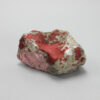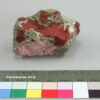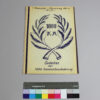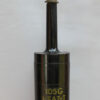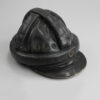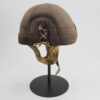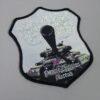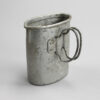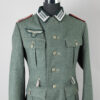Stone with splashes of color from paint strokes, 2019
Inventory number: DPM 7.266
In its 40-year history, the Tank Museum has been the target of much encouragement, but also criticism. Museums also document their own history in objects. This stone with red and pink speckles bears witness to two paint attacks on the museum. In both cases, a standard 0-series tank, which was standing unsecured on a railroad trailer in a gravel bed in front of the museum grounds, was splattered with paint. This paint dripped onto the stones underneath. In both cases, however, the action was not only directed against the museum as a cultural institution, but also as a representative of the Bundeswehr and the German government’s defense policy.
In 2012, the autonomous group “Rosa Tank Gang” carried out the first paint attack on the museum building. They doused the tank with pink paint and threw paint bags over the fence of the museum grounds into the entrance area. The reason for the action was the imprisonment of Hanna Poddig that night. The activist had chained herself to railroad tracks in 2008 and blocked the transportation of Bundeswehr vehicles to a manoeuvre with other demonstrators. Poddig was sentenced to a fine. Instead, she decided to serve a 90-day substitute prison sentence in Frankfurt Prison in 2012. According to the letter of confession, the paint attack on the tank museum was directed “against the warlike and economically motivated deployments of the Bundeswehr abroad”.
It hit the museum because it has allegedly “been known for years for these glorifying depictions of war, crime and murder. It is used exclusively for propaganda. Children and young people in particular are given a totally glorified image of the military and war.” The group did not respond to the museum’s offers to talk. The pink paint used was removed from the tank.
The second paint attack on the tank in front of the museum grounds in 2019 was carried out with red paint. The vehicle was painted with the symbol “Hammer and Sickle” and the slogan “War to War”. The slogan was probably based on the famous anti-war work “Krieg dem Kriege” by Ernst Friedrich from 1924. Unlike the first paint job, there was no letter of allegiance. The paint caused more damage to the building and the contaminated soil also had to be disposed of professionally. In view of the time-consuming cleaning of the object, the museum authorities then decided to remove the staging and store the tank in the museum depot. Ironically, the first paint attack had one major advantage for the tank museum in particular: the damage was minor and the public attention was high. The incident was covered in the national press such as Spiegel, Stern and Morgenpost. The museum’s social media channels suddenly became more popular and the museum’s statement on the paint attack with the announced transformation process of the museum was noticed by many more people. Since then, the museum has reached an increasing number of people with its content.
Object of the month
(short) stories from the depot
Unfortunately, many objects cannot currently be shown in the exhibition for conservation reasons. Here you will find unusual objects and exciting stories of special pieces from the depot


